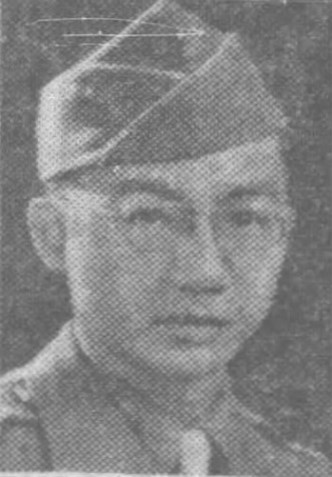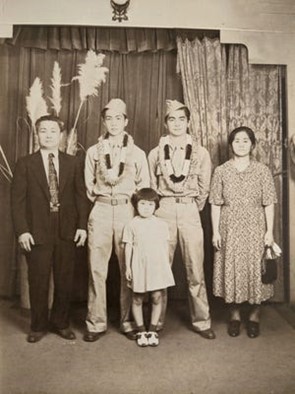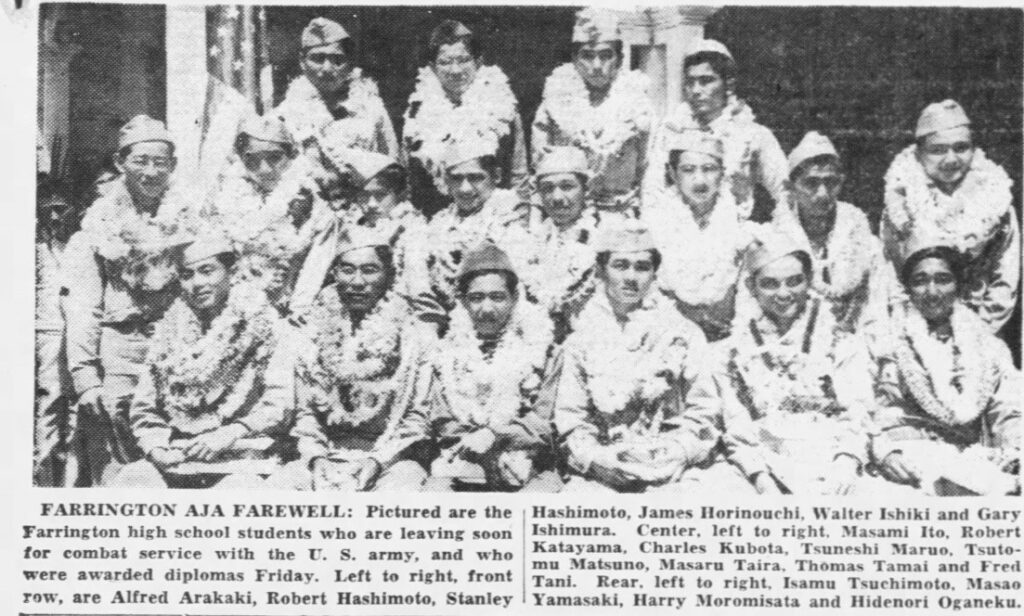
Masaru Taira
Private
442nd Regimental Combat Team
3rd Battalion, L Company
Masaru Taira was born on December 28, 1924, in Honolulu, Territory of Hawaii. He was the son of Kame and Kamato (Uehara) Taira, who emigrated from Shimajiro District, Okinawa Prefecture, Japan, in 1907 and 1913, respectively. There were twelve children in the Taira family: sons Masaichi, Masaru, Wilfred S., Walter T., Richard S., and Harry S.; and daughters Hatsue, Mary Ann Masako, Chiyoko, Haruko, Jane Miyoko, and Blanche Sueko.
In 1930, the family lived on Robello Lane and father Kame was a baker at a bakery shop. Masaru attended Kaiulani School and Kalakaua Intermediate School. Like most other Japanese American youth, he also attended Japanese language school in the afternoon after regular school. In 1939, he was a member of the Kalakaua School’s Future Farmers of America (FFA) Chapter 48. In an agricultural demonstration that spring, Masaru was on the Plant Life exhibit team.
By 1940, the family was living at 680 North King Street and father Kame was the proprietor of the Palama Bakery. He later also owned the Palama Hot Dog Shop. At the end of 1940, Masaru was among the 667 students at Kalakaua Intermediate to receive a 9th-grade graduation certificate.
Masaru signed his draft registration card on December 28, 1942, his 18th birthday, Local Board No. 6, at the National Guard Armory at Hotel and Miller Streets. He lived with his family at 680 North King Street. His point of contact was Taro Teruya. Masaru was a part-time employee at the Hawaiian Pineapple Company and also a student at Farrington High School. He was 5’4” tall and weighed 105 pounds.

On March 25, 1943, Taira enlisted in the U.S. Army. He had completed three years of high school and his occupation was “Semi-skilled occupation in canning/preserving foods.” He was sent to the “tent city,” nicknamed Boom Town, at Schofield Barracks. His brother Wilfred enlisted the same day. Their parents had a photograph made with them at a studio in Honolulu shortly before they left.
Father Kame, Masaru, Wilfred, and mother Kamato, with youngest child, Blanche – 1943
Below: 1943 High School graduation – Taira is 2nd row, 3rd from right

The new soldiers were given an aloha farewell ceremony at Iolani Palace on March 28. On April 2, the Farrington High School seniors who were among the new soldiers were given their diplomas in a special commencement ceremony.
The 18 soldier-graduates were selected from 40 student applicants who volunteered. Sixteen were seniors and two were juniors. Oren E. Long, Superintendent of Public Instruction, said in his address that
“your strength now belongs to all America, not just Hawaii.”
The 442nd volunteers sailed on April 4 on the S.S. Lurline for Oakland, California, where they were sent on a train trip across the US. Masaru wrote to his family about an incident on the train when some Red Cross ladies offered the soldiers refreshments:
The Ladies were very kind to us, and some of the boys tried to donate some money to the Red Cross in appreciation, but was [sic] refused by the ladies, who said that they need not contribute because they were in the Army – and that’s plenty…I hope you would take notice of this incident because it did happen and it made me feel very proud.
They arrived at Camp Shelby, Mississippi, where they were assigned to their units. Private Taira was assigned to 3rd Battalion, L Company.
While at Camp Shelby, in March 1944, Masaru and some fellow soldiers traveled 250 miles to the Jerome WRA Relocation Camp in Arkansas. The purpose of the trip was to visit the former principal of their Japanese language school. In a letter he sent home, he wrote that the principal’s wife “was very swell to us – in fact, it was almost like home.”
After a year of basic and specialized training and field maneuvers, the 442nd left by train for Camp Patrick Henry, Virginia, on April 22, 1944. On May 2, they left from nearby Hampton Roads in a convoy of about 100 ships, and arrived at Naples, Italy, on May 28. Private Taira and L Company were aboard the S.S. George W. Campbell.
As the ship neared port, Masaru wrote in another letter home:
We will be in our foxholes sometime in the near future. This boat ride is a cinch, the only thing is it’s too long…Tell Mom not to worry too much. I am in good health and as I always say, ‘I never felt better in my life.’
The Combat Team spent a week at a staging area in nearby Bagnoli before leaving on LSTs for the recently freed Anzio beachhead on June 6, where they marched five miles to a bivouac area. From Anzio, the 442nd went by truck convoy around Rome to a larger bivouac area at Civitavecchia, where they went through additional training and final preparations for going to the front lines. The 442nd entered combat in the Rome-Arno Campaign on June 26, 1944, near Suvereto, about 107 miles north of Civitavecchia. Thus began the series of fierce battles to push the enemy north along the west coast of Italy, with the mission of liberating Pisa.
Taira was assigned as one of the L Company runners for communication with Headquarters.
The enemy was pushed north from Suvereto to the Cecina River by July 1. By the next morning, the 100th and 2nd Battalions had crossed the easily fordable river. Resistance was not heavy but was stiffening, indicating that the enemy would make a stand on the high ground at Hill 140 just north of the river.
On July 3, enemy artillery fire became increasingly heavy. By 12:00 p.m. on July 4, the 3rd Battalion had crossed the Cecina River and relieved the 100th in position. As this was done in broad daylight, it brought down a storm of enemy self-propelled and artillery fire, inflicting numerous casualties on the 442nd.
Masaru was killed on July 4, 1944. As L Company’s Master Sergeant Jun Yamamoto later recalled:
…we were near Cecina and relieving the 100th. Our machine gun crew and Headquarters runners had moved into position and set up. They were exposed and the Jerries had the area zeroed in. A German 88 shell exploded and the whole gun crew was gone! I believe the gun crew was John Takayama, Jiro Tanaka, Masaru Tengan, Hidetoshi Tokusato, and Shinake Toyama. The Headquarters men were Denis Hashimoto and Masaru Taira.
The field hospital admission card indicated that Private Taira was hit in the thorax and arm by shrapnel
Private Masaru Taira was buried at the U.S. Military Cemetery at Follonica, 35 miles south, in Plot B, Row 24, No. 278. He was survived by his parents, and siblings Wilfred, Walter, Richard, Harry, Hatsue, Mary Ann Masako, Chiyoko, Haruko, Jane Miyoko, and Blanche Sueko.
For his military service in World War II, Private Masaru Taira was awarded the: Bronze Star Medal, Purple Heart Medal, Good Conduct Medal, European-African-Middle Eastern Campaign Medal with one bronze star, World War II Victory Medal, and Combat Infantryman Badge. He was posthumously awarded the Congressional Gold Medal on October 5, 2010, along with the other veterans of the 100th/442nd Regimental Combat Team. This is the highest Congressional Civilian Medal.
The Taira family held a memorial service for their son on July 31, 1944, at 3:00 p.m. at the Jikoyen Temple on Houghtailing Street. On August 1, they had a Card of Thanks printed in the newspaper for all the kindnesses and floral offerings received from their relatives and friends during their recent bereavement.
Taira’s L Company friend, Pfc. Hideo Nakayama, wrote to sister Edith Taira:
His death was a blow to us, he was just like a brother to me…At first, we couldn’t believe it, for he was killed in the same barrage with our machine gun boys. He was a Battalion runner when we came to Italy…July fourth is no holiday for us, for that’s the day your brother was killed with the rest of our company boys.
The following year, 1945, two public memorials were held. On November 20, Farrington High School remembered its 19 alumni who were killed in the war. The service was attended by about 500 students, teachers, and families. The Reverend Harry Komuro of Harris Memorial Church prayed that “we be worthy of the ideals our soldiers died for.”
On December 9, a Memorial Service for 266 veterans of the 100th/442nd, including Masaru Taira, was held at McKinley High School auditorium in Honolulu. The service was sponsored by the 100th Battalion and the 442nd veterans, the Women’s War Service Committee, and the Emergency Service Committee. Lt. General Robert C. Richardson gave the main address.
After the war, most of the U.S. Military Cemeteries overseas were closed. Families were given the option of having their loved one reburied in one of the few remaining cemeteries or returned home. The Taira family chose to have their son brought back to Hawaii.
As a result, Private Masaru Taira arrived on December 24, 1948, aboard the USAT Sinnett at 8:30 a.m. at Pearl Harbor’s Dock M-3. He was among 122 war dead on the ship, which was greeted by over 700 family and friends as the 264th Army Band played Aloha Oe. A brief memorial service opened with a moment of silence, then a prayer by Army Chaplain Eugene L.A. Fisher. Secretary of Hawaii Oren E. Long said in his remarks:
We are proud to have had such sons. These men stood the test of action and added a new chapter of American heroism to our history.
A benediction by Navy Chaplain Wendell Wheeler concluded the service. The crated and flag-draped caskets were taken to the Army Mausoleum at Schofield Barracks until funeral arrangements were made.
Masaru Taira was reburied in the Taira family plot at Moiliili Japanese Cemetery, Section B, Site 179C in Honolulu.
His brother Wilfred S. Taira served as a Medic in the 442nd RCT.
Researched and written by the Sons & Daughters of the 442nd Regimental Combat Team in 2023
